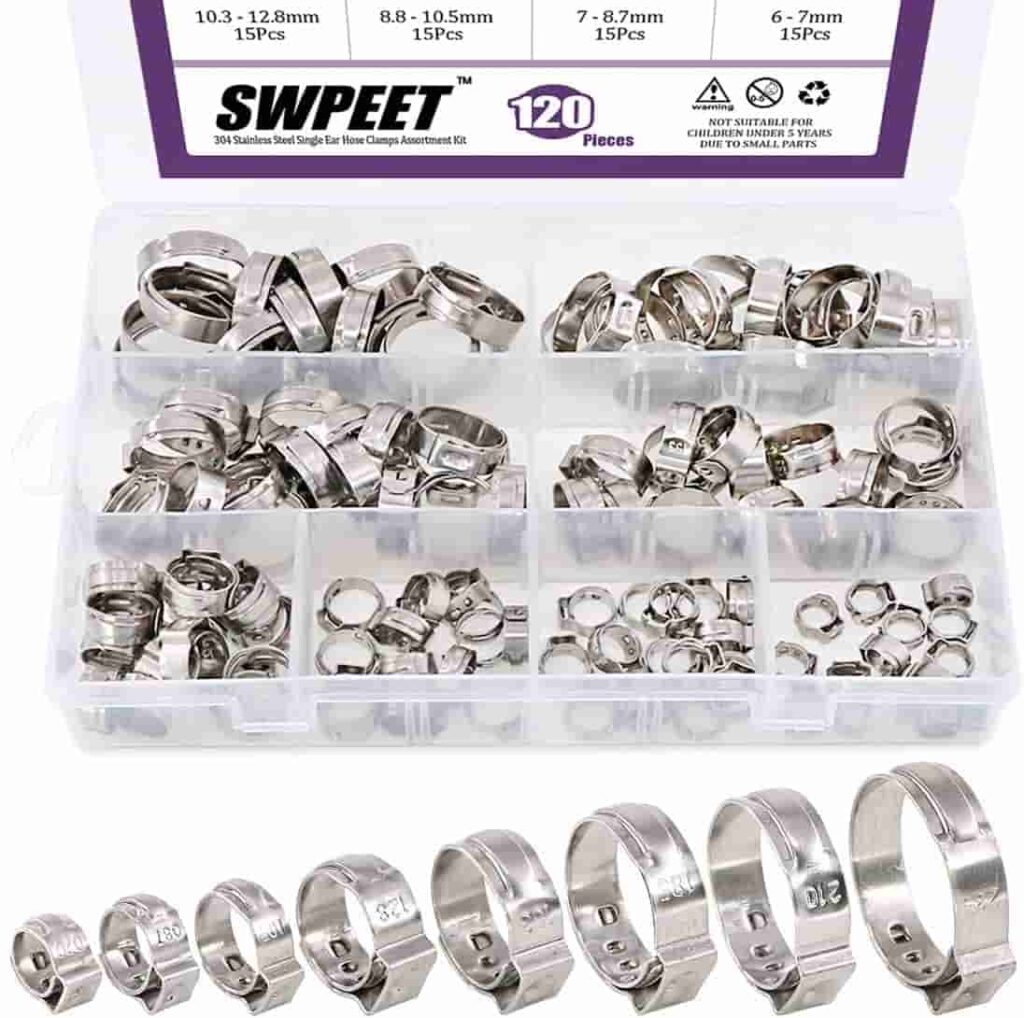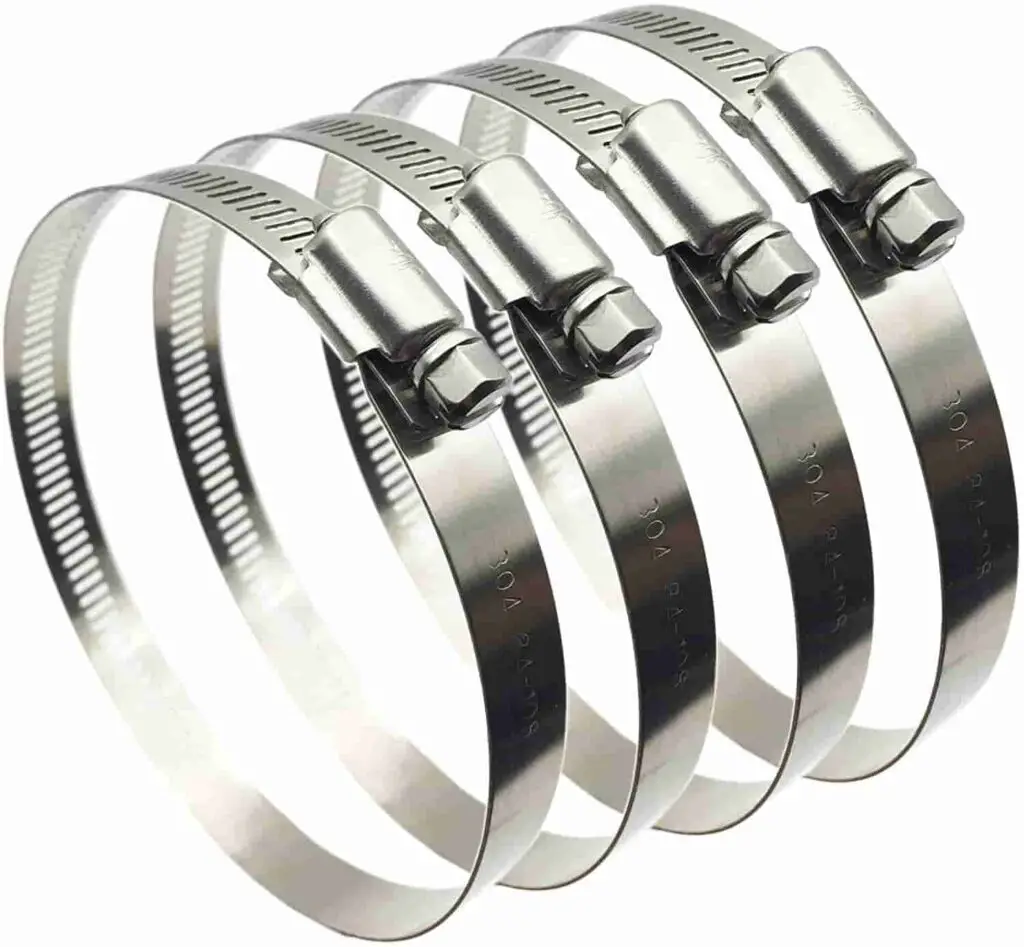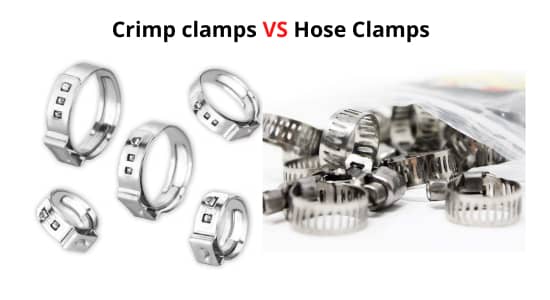Clamps are flexible tools that hold an item securely in place temporarily. They have a different use, such as welding, woodworking, carpentry, automobile, and metallurgy. Crimp clamp and hose clamp are the two variations of a clamp. But when comparing crimp clamps vs hose clamps, there are several distinctions, most of which favor hose clamps.
Hose Clamps have a large stainless steel strap wrapped around them, and a screw is available that you can utilize to stretch the band. Crimp clamps on the other hand contain a metal strip that wraps around like a hose clamp but is slightly thicker.
Still, you have a lot to know about it. Just read till the end of this article and find out more!
See More: Spring hose clamps vs screw
What are Crimp Clamps?
Crimp clamps are a reasonably simple device to attach a hose with the pipe or fitting, such as a pipe rod connection. The clip is a metal strip like an ear, and each side of them is connected to secure the ring of the hose. Also, it is crucial to tighten crimp clamps along the same tool stroke.
Pros:
- Crimp clamps are slightly cheaper than hose clamps.
- The crimp hose clamp kit is practical and smooth to install.
Cons:
- You have to use a unique tool to remove it.
What are Hose Clamps?
Hose clamps are an appropriate tool attached with a hose fitting, like a barb or nipple. These devices have come out to stabilize and seal any hose assembly. Finally, the clips help prevent fluid from leaking around the device.
Pros:
- The installation of this clamp is relatively straightforward with a straight screwdriver or 7 to 8mm wrench.
- They are available everywhere.
Cons:
- You may need retorquing to have a leak-free service.
A quick comparison chart: crimp clamps vs hose clamps
| Basis of Comparison | Crimp Clamps | Hose Clamps |
| Durability | Moderate | Excellent |
| Price | 0.3$ to 0.5$ per pcs | 0.5$ to 0.7$ per pcs |
| Inner Diameter Range | 7.0mm-19.8mm | 2.8mm-15.3mm |
| Corrosion Resistance | Medium | High |
| Temperature resistance | Medium | High |
| Pressure resistance | Medium | High |
| Variation | Less | More |
| Reusability | Not | Yes |
Check Also: Nylon vs Stainless Braided Hose
Crimp Clamps vs Hose Clamps: Key Differences
We have used both clamps and observed different users’ feedback to understand which one is best. Following are the detailed differences between them.
- Types:
When we go for hose clamp types, we may find four main categories of hose clamps. They are spring, screw, ear, and wire. Different clamps have different users based on the hose and end fitting. But when we go for the crimp hose clamps types, we will not have many variations.
- Durability:
The standard hose clamp, the automotive clamp, contains galvanized stainless steel or just stainless steel with a mild silver-colored steel screw.
Even the quality of the steel is also high. That’s why hose clamps are more durable than crimp clamps. But the quality of the crimp clamp’s steel is a bit lower.
- Rust Resistance:
Every hose clamp of a boat contains high-quality stainless steel to withstand corrosion. Galvanized or plain steel clamps may rust and deteriorate. The clamp fittings of a hose clamp are a minimum of 316 stainless steel in general. So, they are highly resistant to rust.
On the other hand, most of the crimp clamps use 300 series stainless steel. That’s why they are less resistant to rust.
- Removal operation:
Crimp hose clamps removal is quite a challenging task. You have to use a special tool, like a rotary tool, to remove the clamp. But you can remove a hose clamp quite simply by using a screwdriver.
- Price:
The price of a crimp clamp is a little cheaper ( about 0.3$ to 0.5$ per pcs). On the other hand, you have to pay around 0.5$ to 0.7$ per pcs for a hose clamp.
- Reusability:
You can use a crimp clamp just for one time, but hose clamps are reusable.
Best Crimp Clamp
- Swpeet Stainless Steel Single Ear Hose Clamps

This Crimp Clamp is made of stainless steel of the highest quality. It is corrosion and rust resistant to a high degree. It is commonly utilized with car hoses, residential water and gas lines, machinery equipment, and so on.
Because of its longevity, you may easily recycle and reuse it.
Because of its versatility, it can be used in a variety of ways. Its unique size and design, as well as its ease of installation and removal, make it easy to use.
- LOKMAN Stainless Steel Single Ear Hose Clamp

It’s composed of A-grade stainless steel, which resists salt and corrosion. The crimp clamp has a 360° circular design with no steps or gaps in the inner circle, ensuring consistent surface compression of the hose.
Lock forces are concentrated in a narrow ear. Strip edges that have been specially shaped limit the possibility of harm to the clamped portion.
Best Hose Clamp
- Koehler Enterprises Hose Clamp

Koehler hose clamps are precisely designed to provide long-lasting and reliable performance in most typical home, industrial and automotive applications.
These universal clamps feature 0.5″ stainless steel strips for most corrosion protection to salt and other chemicals. The body and 5/16 inch hex head screw contain metalized carbon steel for high-stress strength.
- EesTeck Stainless Steel Hose Clamp

EesTeck hose clamps contain high-quality stainless steel, rust-resistant, waterproof, strong, corrosion-resistant, and durable. It has an open outer and inner ring design and is bolted.
Smooth facade, resistant to torsion and pressure, securely fixed, with a wide range of adjustments.
It provides excellent sealing for various hose materials and effectively resolves the predicament of gas and liquid leakage from your hose.
Check More: Silicone vs Rubber Vacuum Hose
Final Verdict:
This part of the “crimp clamps vs hose clamps” will be a little tough because we will finalize which one you have to go with.
The hose clamps are removable and fully reusable. No additional tools are required to install it other than a flat head screwdriver. The hose clamps can slacken after a long period due to external forces loading the screw.
So you have to check the screw timely to ensure that it is secured and tight. Hose clamps can also exert uneven pressure, and you can’t use them for all purposes. It may cause some pipe deformation, although this is usually not significant in all cases.
On the other hand, you can use crimp clamps for almost anything, as long as they are used on pipes that are not frequently serviced. They are ideal for fuel, oil, and refrigeration lines.
Still, you should not use them if you have to remove them often. But for the service with its low price, you can quickly go with it.

